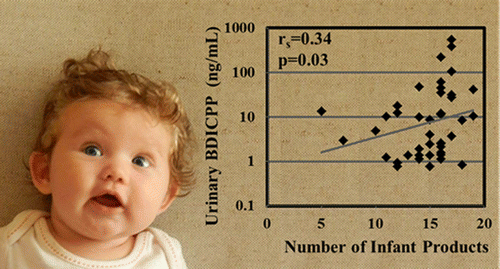Study finds flame retardant exposure higher in infants than adults

In October, Macy's joined a growing list of major retail stores that have pledged to stop selling furniture containing flame retardants, which research suggests could cause developmental problems. Despite the trend, however, it could take years before widespread exposure declines. And now, a study in ACS' journal Environmental Science & Technology has revealed more bad news: Infants could potentially be affected the most. The report also looks at potential exposure routes.
One kind of flame retardant, polybrominated diphenyl ethers or PBDEs, was phased out in 2005 out of concern for associated health risks. They were replaced by other substances, including organophosphate flame retardants (PFRs). But over the past 10 years, studies have suggested that PFRs might have problems similar to their predecessors'. One type of PFR is now considered a probable human carcinogen; others could potentially affect reproduction and development. Studies have reported widespread exposure to PFRs among adults and young children. Although some manufacturers are phasing out these flame retardants, others continue to apply them to products, and the substances linger in older products. Since PFRs are still often used in strollers, nursing pillows and a number of other baby products, Heather M. Stapleton and colleagues wanted to see whether infants were getting exposed, too.
The researchers tested urine from more than 40 infants between 2 months and 18 months old. Byproducts of some PFRs were in most samples and at concentrations higher than has been reported in adults. The team found that infants with higher levels lived in homes with more than 16 baby products, such as bouncers and swings. Also, compared to infants in home care, infants in daycare centers had higher levels of one particular metabolite. The researchers said additional studies would be needed to further flesh out whether flame retardants are getting inhaled or ingested through dust, what levels could affect babies' health and how to reduce their exposure.
More information: Kate Hoffman et al. High Exposure to Organophosphate Flame Retardants in Infants: Associations with Baby Products, Environmental Science & Technology (2015). DOI: 10.1021/acs.est.5b03577
Abstract
Infant products containing polyurethane foam are commonly treated with organophosphate flame retardants (PFRs), including tris(1,3-dichloro-2-propyl)phosphate (TDCIPP) and triphenyl phosphate (TPHP). Infants may have greater exposure due to greater contact with these products, yet little is known about levels of exposure or the factors contributing to higher exposure. We recruited children age 2–18 months from North Carolina to investigate PFR exposure (n = 43; recruited 2014–2015). Parents provided information on potential sources and modifiers of exposure, and reported whether they owned common infant products. We measured five PFR metabolites in urine samples collected from children. TDCIPP and TPHP metabolites (bis(1,3-dichloro-2-propyl) phosphate (BDCIPP) and diphenyl phosphate (DPHP)) were most commonly detected (>93% detect). Other metabolites were detected infrequently (<35% detect). Although we did not observe a clear age trend for infants, BDCIPP levels were substantially higher than those reported for adults (geometric mean = 7.3 ng/mL). The number of infant products owned was strongly associated with BDCIPP; children with >16 products had BDCIPP levels that were 6.8 times those with <13 (p = 0.02). Infants attending daycare centers also had higher BDCIPP levels (3.7 times those of others; p = 0.07), suggesting time spent in this microenvironment contributes to higher exposure. In contrast, DPHP levels were not related to products owned, time in different microenvironments, or behavior.
Journal information: Environmental Science & Technology
Provided by American Chemical Society

















